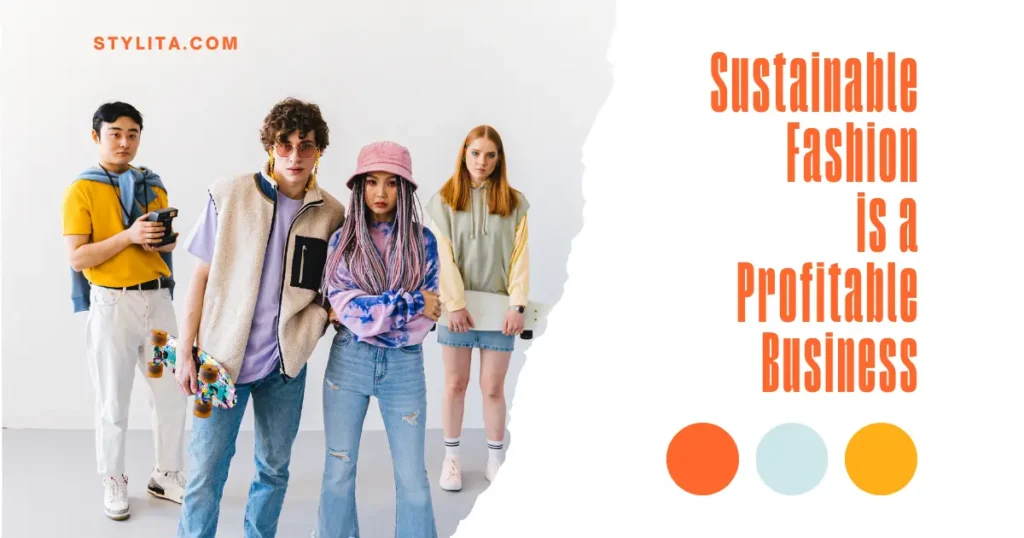In the ever-evolving world of fashion, a pivotal question echoes through boardrooms and boutiques alike: “Is Sustainable Fashion Profitable for Your Business?” This isn’t just a tale of trends; it’s a narrative woven with environmental consciousness, ethical considerations, and, of course, the pursuit of profit.
Imagine a landscape where consumer preferences are shifting, not just towards the latest fashion, but towards a deeper consideration of the sustainability and ethical impact of their choices. This shift isn’t just a passing breeze; it’s a seismic transformation that has given rise to what we now know as sustainable fashion.
Let’s navigate the numbers, assess the trends, and draw insights from industry experts to answer definitively: Is Sustainable Fashion Profitable for Your Business? So, fasten your seatbelts as we explore the dollars and sense behind this green transformation.
A Green Transformation Unveiled
In the ever-evolving landscape of the fashion industry, a paradigm shift is underway—one that transcends the confines of trends and styles, paving the way for a Green Transformation. This transformation is not merely a buzzword; it is a fundamental restructuring of the industry’s DNA, embodying values of sustainability, environmental stewardship, and ethical responsibility.
At its core, the Green Transformation represents a departure from the conventional, often wasteful, practices that have long characterized the fashion world. It is a conscientious response to the growing concerns surrounding climate change, resource depletion, and the environmental toll exacted by the fast-paced fashion cycle.
Consumer awareness has played a pivotal role in propelling this transformation forward. Today’s consumers are not just fashion enthusiasts; they are conscious decision-makers, seeking products that align with their values. The Green Transformation responds to this demand, offering an alternative narrative that goes beyond aesthetics—focusing on the impact of each garment from creation to disposal.
The rise of sustainable materials is a cornerstone of this transformation. From organic cotton to recycled polyester, the industry is witnessing a proliferation of eco-friendly alternatives that reduce dependence on finite resources and minimize environmental harm. Brands are increasingly incorporating these materials into their designs, not just as a nod to sustainability but as a strategic move to align with the values of an evolving consumer base.
Beyond materials, the Green Transformation encompasses changes in production processes and supply chain practices. Sustainable sourcing, ethical labor practices, and a commitment to transparency are becoming non-negotiable elements of the fashion ecosystem. Brands are not only reimagining their products but also reassessing the entire lifecycle of their creations.
As the Green Transformation unfolds, fashion is becoming a vehicle for positive change. It’s not merely about creating beautiful garments; it’s about crafting a narrative that respects the planet and empowers consumers to make environmentally conscious choices. This transformation is challenging traditional norms, prompting businesses to rethink their strategies, and fostering a culture of innovation within the industry.
In essence, the Green Transformation is an unfolding story—one where sustainability, once a niche concern, is now taking center stage. It is a journey towards a more responsible and equitable fashion future, where every thread tells a story of positive impact. As we delve deeper into this narrative, we uncover not just a transformation in color palettes and designs but a revolution that seeks to redefine the very essence of fashion itself.
Consumer Tastes and Trends
In the ever-evolving landscape of the fashion industry, understanding consumer tastes and trends has become more crucial than ever. Today’s consumers are not merely passive recipients of fashion; they are active participants, wielding the power to shape the industry’s direction through their preferences and choices.
The emergence of sustainable fashion as a dominant force is intricately linked to shifts in consumer tastes and trends. It’s not just about what looks good on the runway; it’s about what resonates with the environmentally conscious and ethically aware modern consumer. This shift marks a departure from the era of fast fashion, where trends were fleeting, and garments were viewed as disposable commodities.
The modern consumer is more discerning, seeking products that align with their values. The keywords here are not just style and aesthetics but also sustainability and ethical production. In a world where information is at our fingertips, consumers are increasingly educated about the impact of their choices. They are not just buying a piece of clothing; they are investing in a narrative—an ethos that reflects their commitment to a more sustainable and ethical lifestyle.
Consumer Tastes and Trends
Brands that understand and respond to these shifting consumer tastes and trends are poised for success in the contemporary fashion landscape. It’s not merely about predicting the next big color or pattern; it’s about anticipating the demand for sustainable fashion. This involves a deep dive into the desires and values of the target audience—what makes them tick, what drives their purchasing decisions, and how their values align with the brand’s mission.
Consumer tastes and trends also extend beyond the realm of aesthetics to encompass the overall experience. The modern consumer seeks transparency, wanting to know the story behind the garments they wear. This narrative includes the sourcing of materials, the ethical treatment of workers, and the brand’s commitment to reducing its environmental footprint.
In this era of connectivity, social media platforms play a pivotal role in shaping and amplifying consumer tastes and trends. Influencers and fashion advocates wield significant influence, and their choices can propel a brand into the limelight or relegate it to the sidelines.
As we navigate the intricate web of consumer tastes and trends, it becomes evident that the key to success lies in aligning with the values of the modern consumer. The fashion industry is no longer solely about creating visually appealing designs; it’s about fostering a connection, understanding the pulse of the consumer, and responding with agility to the evolving landscape of desires and expectations. The brands that embark on this journey, attuned to the harmonies of sustainability and consumer consciousness, are the ones poised to thrive in this new era of fashion.
Unpacking the Profitable Strategies
In the intricate tapestry of the fashion industry, the pursuit of profitability within the realm of sustainable fashion requires a nuanced understanding of the strategies that underpin success. Unpacking these strategies unveils a world where sustainability, innovation, and financial viability intersect, creating a roadmap for businesses aspiring to thrive in an era where conscious consumerism reigns supreme.
Sourcing Smarts and Supply Chain Efficiency
Central to the profitability equation in sustainable fashion is the adoption of smart sourcing practices and the optimization of supply chain efficiency. Brands that champion sustainable sourcing not only contribute to preserving the environment but also position themselves for long-term cost-effectiveness. As consumers increasingly demand transparency, understanding and showcasing the origins of materials become essential elements of brand credibility.
For instance, major players like H&M are actively committed to transitioning to 100% sustainably sourced or recycled materials by 2030. This strategic move not only aligns with their environmental goals but also ensures a reliable supply of materials at predictable costs, a crucial aspect in maintaining profitability.
Circular Fashion Economy: A New Paradigm
Enter the era of the circular fashion economy—a paradigm that redefines the traditional linear model of production and consumption. Here, garments are designed for longevity, recyclability, and minimal environmental impact. Brands championing this approach, such as Patagonia, are not just creating products; they are fostering a culture of sustainability by encouraging customers to return worn-out garments for recycling.
The circular fashion economy is not merely an environmental initiative; it’s a profitable strategy that reduces waste, lowers production costs, and fosters customer loyalty. Brands that embrace this approach position themselves at the forefront of a transformative movement in the fashion industry.
Overcoming the Hurdles
Initial Investment and Scaling Woes
While the long-term benefits of sustainable fashion are evident, businesses often face initial hurdles, especially regarding the investment required for the transition. However, the key lies in strategic planning and a phased approach. Brands like Adidas showcase a gradual but impactful integration of sustainability initiatives, including the use of recycled materials, into their core identity. This phased approach not only minimizes financial strain but also demonstrates a commitment that resonates authentically with consumers.
Conclusion
In the grand narrative of fashion, where trends ebb and flow, sustainability emerges not just as a trend but as a pivotal component of profitability. The strategies unpacked here go beyond conventional business approaches; they embody a commitment to ethical choices that resonate with the growing cohort of conscious consumers.
In conclusion, as businesses navigate the complex waters of sustainable fashion, the profitable strategies unveiled—smart sourcing, circular economies, and strategic scaling—serve not just as pathways to financial success but also as ethical choices that define a brand’s legacy in an industry undergoing a profound transformation.



